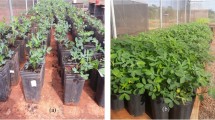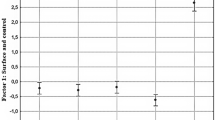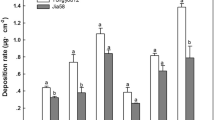Summary
Employing four test plants (Brassica napus, Fagopyrum esculentum, Pisum sativum andTriticum vulgare) the effects of varying the spray output (0.55 to 20.0 mm3/cm2) and the nozzle orifice (mean mass diameter of spray droplets 160–408 µ) on retention by the shoots of young seedlings were first investigated. As long as the nozzle output did not exceed 15 mm3/cm2, then for each species and for each nozzle the level of retention was proportional to the volume of spray reaching the leaf surface. For a given output the proportion retained was inversely related to the mean droplet size. The magnitude of this effect was greatest forT. vulgare and least forP. sativum.
Lowering the surface tension of the spray solution or pretreating plants ofP. sativum with trichloroacetic acid diminishes the contact angle made between the drops and the leaf surface and this reduction in the angle is associated with a higher retention ratio.
The relation between the amount of spray retained and the concentration of 2,4-dinitro-o-cresol (DNC) required to kill half the plants ofF. esculentum, P. sativum andB. napus was studied. For each species, irrespective of spray output or mean droplet size the equi-effective dose of DNC remained constanti.e. the equi-effective concentration was constantly and inversely proportional to the level of retention per unit surface.
Statistical analysis of a series of experiments undertaken at different seasons of the year onB. napus demonstrated that the magnitude of the equi-effective dose of DNC was primarily dependent on the total solar radiation received during the first few hours after the spray application.
Similar content being viewed by others
References
Adam, N. K., The Physics and Chemistry of Surfaces. Oxford Univ. Press (1942).
Blackman, G. E., Studies in the principles of phytotoxicity. I. The assessment of relative toxicity. J. Exptl. Botany3, 1–27 (1952).
Blackman, G. E., Bruce, R. S. and Holly, K., Studies in the principles of phytotoxicity. V. Interrelationships between specific differences in spray retention and selective toxicity. J. Exptl. Botany9, 175–205 (1958).
Blackman, G. E., Holly, K. and Roberts, H. A., The comparative toxicity of phytocidal substances. Symposia Soc. Exptl. Biol.3, 283–317 (1949).
Blackman, G. E. and Robertson-Cuninghame, R. C., Interrelationships between light intensity and the physiological effects of 2,4-dichloro-phenoxyacetic acid on the growth ofHelianthus annuus. J. Exptl. Botany6, 177–211 (1955).
Bliss, C. I., The method of probits. Science79, 38–39 (1934).
Brunskill, R. T., Physical factors affecting the retention of spray droplets on leaf surfaces. Proc. Brit. Weed Control Conf. 3rd Conf., 593–603 (1956).
Dewey, O. R., Gregory, P. and Pfeiffer, R. K., Factors affecting the susceptibility of peas to dinitroherbicides. Proc. Brit. Weed Control Conf. 3rd Conf., 313–326 (1956).
Eggink, H. J. and Riepma Kzn, P., De voor onkruidbestrijdingsmiddelen gevoelige stadia van graangewassen. Verslag Centraal Inst. Landbouwk. Onderzoek1950, 121–128 (1951).
Eichborn, J. L. von, Zur Frage des gegenseitigen Haftens räumlich nicht mischbarer Stoffe. Probleme der Randwinkel insbesondere von Flüssigkeiten an Festoberflächen. Kolloid Z.107, 107–113 (1944).
Finney, D. J., Probit Analysis. Cambridge Univ. Press (1952).
Fisher, R. A. and Yates, E., Statistical Tables for Biological, Agricultural and Medical Research. Oliver and Boyd, Edinburgh (1948).
Fogg, G. E., Quantitative studies on the wetting of leaves by water. Proc. Roy. Soc. London B134, 503–522 (1947).
Fogg, G. E., The penetration of 3,5 dinitro-o-cresol into leaves. Ann. Appl. Biol.35, 315–330 (1948).
Hellquist, H., The effect of volume application rate on the retention and activity of herbicides. Kgl. Lantbruks-Högskol. Ann.22, 41–92 (1955).
Hull, H. M., The effect of day and night temperature on growth, foliar wax content and cuticle development of velvet mesquite. Weeds6, 133–142 (1958).
Lewis, H. C., Edwards, D. G., Goglia, M. J., Rice, R. I. and Smith, L. W., Atomization of liquids in high velocity gas streams. Ind. Eng. Chem.40, 67–74 (1948).
Nukiyama, S. and Tanasawa, Y., An experiment on the atomization of liquid by means of an airstream. Trans. Soc. Mech. Engrs. Japan.4, 86–94 and 138–143 (1938) and5, 63–67 (1939).
Meggitt, W. F., Aldrich, R. J. and Shaw, W. C., Factors affecting the herbicidal action of aqueous sprays of salts of 4,6-dinitro-ortho-secondary butylphenol. Weeds4, 131–138 (1956).
Pfeiffer, R. K., Dewey, O. R. and Brunskill, R. T., Further investigations on the effect of pre-emergence treatment with trichloroacetic and dichloropropionic acids on the subsequent reactions of plants to other herbicidal sprays. Mimeo. Rept. Fisons Pest Contr. Ltd. Cited according to Weed Abstracts1957, no. 606 (1957).
Pfeiffer, R. K., Gregory, P. and Holmes, H., The use of dinitro weedkillers on winter cereals. Proc. Brit Weed Control Conf. 2nd Conf., 433–445 (1954).
Riepma Kzn, P., Spuittechniek en weersomstandigheden Landbouwk. Tijdschr.66, 99–107 (1954).
Riepma Kzn, P., Grensvlakverschijnselen en selectiviteit. I. Methoden van onderzoek. Verslag Centraal Inst. Landbouwk. Onderzoek 1954, 210–214 (1955).
Riepma Kzn, P., Chemische onkruidbestrijding in granen. (spuittechniek en weersomstandigheden). Landbouwvoorlichting12, 128–133 (1955).
Roberts, H. A. and Blackman, G. E., Studies in selective weed control. III. The control of annual weeds in leguminous crops with 2,4-dinitro-6-secondary butylphenol. J. Agr. Sci.40, 263–274 (1950).
Sampford, M. R., Studies in the principles of phytotoxicity. II. Experimental designs and techniques of statistical analysis for the assessment of toxicity. J. Exptl. Botany3, 28–46 (1952).
Author information
Authors and Affiliations
Rights and permissions
About this article
Cite this article
Riepma Kzn, P. Interrelationships between methods of spray application, retention, and weather conditions on the herbicidal efficiency of 2,4-dinitro-ortho-cresol. Plant Soil 12, 223–248 (1960). https://doi.org/10.1007/BF01343651
Received:
Issue Date:
DOI: https://doi.org/10.1007/BF01343651




